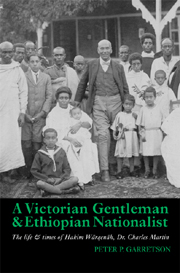 A Victorian Gentleman and Ethiopian Nationalist
A Victorian Gentleman and Ethiopian Nationalist Book contents
- Frontmatter
- Contents
- List of Illustrations
- Transliteration
- Note on the Ethiopian Calendar
- Glossary
- Acknowledgements
- Map 1 Ethiopia 1900–1950
- Map 2 Burma 1898–1919
- Introduction
- 1 Youth & education
- 2 Return to Ethiopia (1896–1901)
- 3 Campaigning in the Ogaden & return to Burma (1901–1907)
- 4 Transitions in life
- 5 A man of substance in Ethiopia & Burma
- 6 Return of a progressive to Addis Ababa (1919–1924)
- 7 An increased pace of modernization (1924–1930)
- 8 International diplomacy, education & recruitment
- 9 Governor of a model province, Chärchär (1930–1935)
- 10 Ethiopian ambassador to the Court of St. James (1935–1936)
- 11 London & India
- 12 Ethiopia
- Conclusion
- Bibliography
- Index
4 - Transitions in life
From Burma to England to Ethiopia (1907–1910)
Published online by Cambridge University Press: 05 April 2013
- Frontmatter
- Contents
- List of Illustrations
- Transliteration
- Note on the Ethiopian Calendar
- Glossary
- Acknowledgements
- Map 1 Ethiopia 1900–1950
- Map 2 Burma 1898–1919
- Introduction
- 1 Youth & education
- 2 Return to Ethiopia (1896–1901)
- 3 Campaigning in the Ogaden & return to Burma (1901–1907)
- 4 Transitions in life
- 5 A man of substance in Ethiopia & Burma
- 6 Return of a progressive to Addis Ababa (1919–1924)
- 7 An increased pace of modernization (1924–1930)
- 8 International diplomacy, education & recruitment
- 9 Governor of a model province, Chärchär (1930–1935)
- 10 Ethiopian ambassador to the Court of St. James (1935–1936)
- 11 London & India
- 12 Ethiopia
- Conclusion
- Bibliography
- Index
Summary
Introduction
A major transition occurred in Wärqenäh's life from 1907 to 1910. Wärqenäh's identity as a citizen of the British Empire, as a man who very much wanted to be assimilated into the imperial elite began to significantly change. This affected not only his intellectual and public life, but also, to a larger degree his private and family life. Major themes in the public and the private spheres of his life intersect during the years when he left for Britain on leave from his Burma position to further his education, until his marriage to an Ethiopian, Qätsälä Wärq Tullu in 1910. His private life would involve his Burmese family, his adoptive British family, a new family with Ethel Watts Fabricius and finally a family in Ethiopia. Publicly, he continued his medical training building on the foundations he had created in Lahore and Edinburgh. In England he continued his study of Amharic and Ethiopian history, and doggedly searched for a new medical position in the Horn of Africa. He also tried to exploit as many personal contacts as he could to raise capital for possible commercial ventures in Ethiopia. These efforts finally bore fruit when he secured a medical position in Ethiopia with the British diplomatic establishment in 1908. Significantly, he went on to become the lead physician to Emperor Menilek and a important figure in the Ethiopian court.
- Type
- Chapter
- Information
- A Victorian Gentleman and Ethiopian NationalistThe Life and Times of Hakim Wärqenäh, Dr. Charles Martin, pp. 51 - 72Publisher: Boydell & BrewerPrint publication year: 2012


